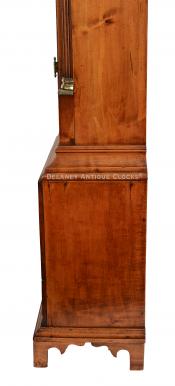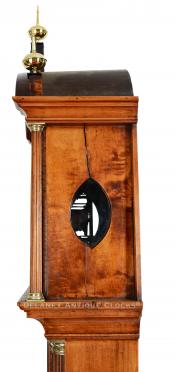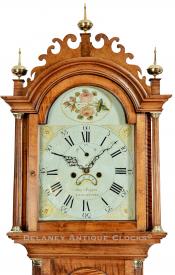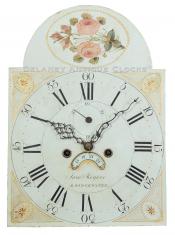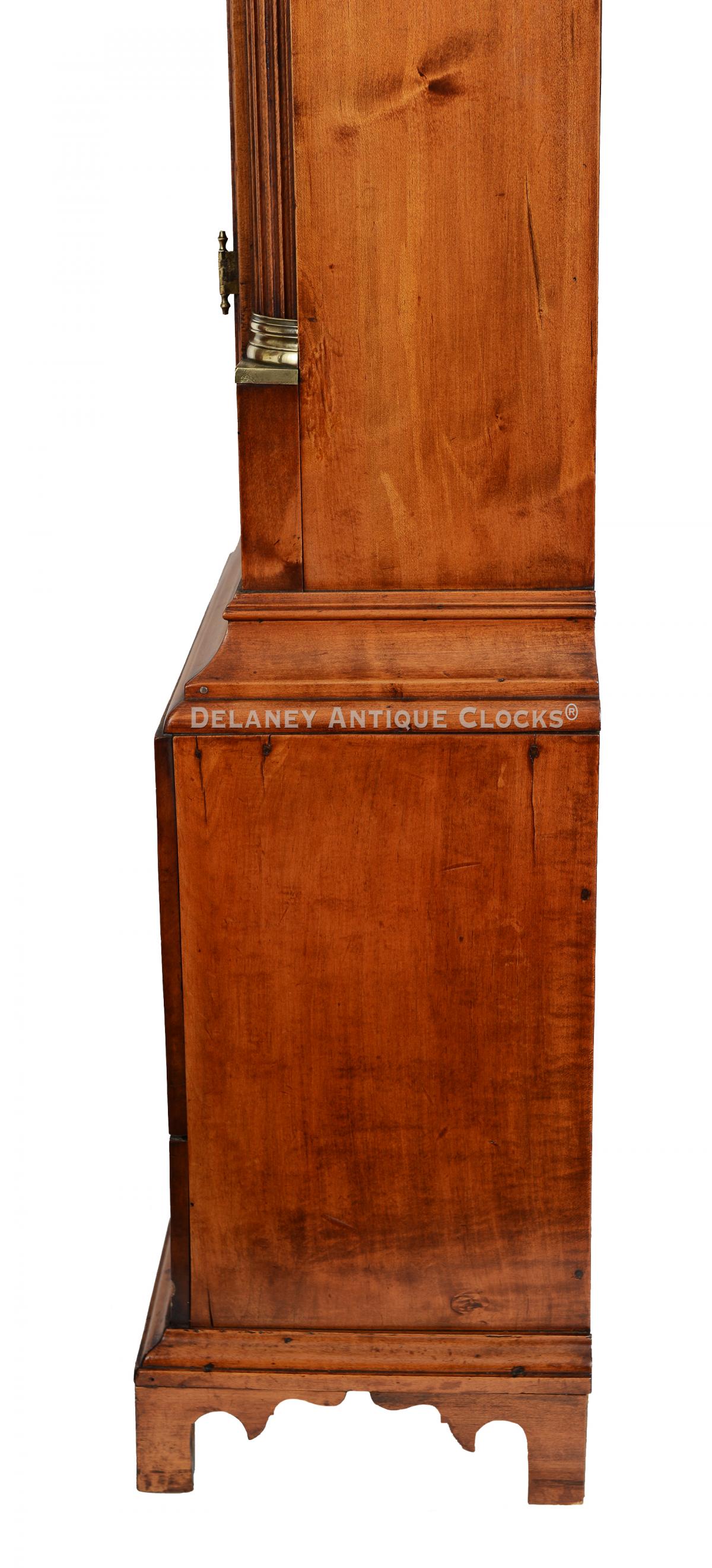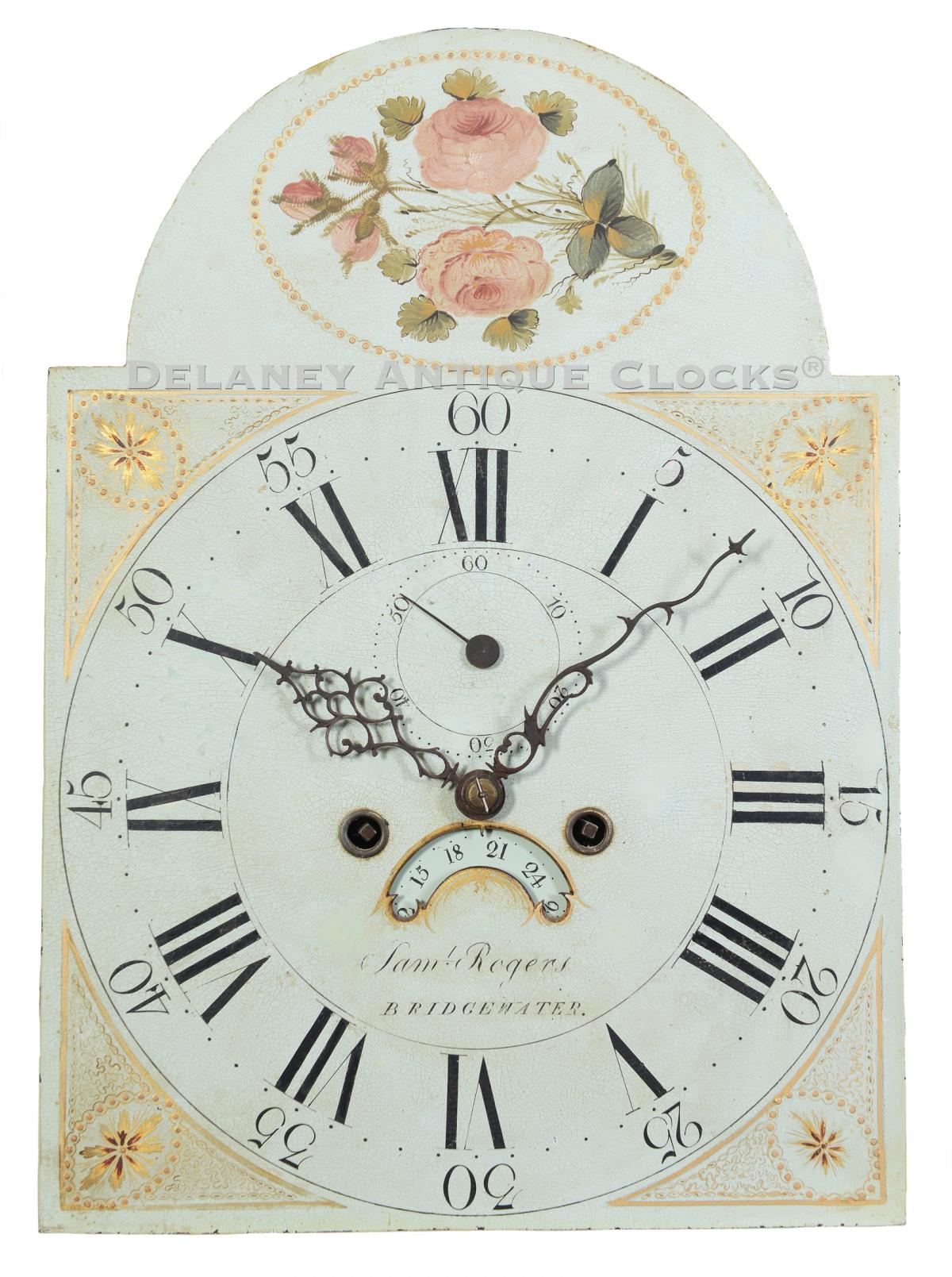Samuel Rogers of Bridgewater, Massachusetts. A boldly figured tiger maple case tall clock. 223246.
This dazzling tiger maple tall clock was made circa 1808 by Samuel Rogers in Bridgwater, Massachusetts. The cabinet exhibits fantastic proportions and wild tiger striping in the maple wood. The boldly formed grain pattern is a visual feast and is more alluring than your typical maple cabinet. Vibrantly-grained wood like this is seldom seen in the marketplace. The tiger striping forms due to the uncommon and inconsistent stressors to the wood fibers as the tree grows. When the fibers twist and compress upon themselves, they occasionally produce the distorted grain pattern recognizable in tiger maple furniture.
The case features a warm, honey-color finish that enhances the tiger graining. The delicate bracket feet are applied to the base molding. The feet are formed with attractive returns. The base panel is positioned horizontally, resulting in the grain pattern being set up like the stalactites and stalagmites in an ancient cave. The waist section centers a tombstone-shaped door. This opens to access the tow drive weights and the brass-faced pendulum bob. The front corners of the case are flanked by fluted quarter columns that terminate in brass quarter capitals. The molded arched bonnet features a cascading whale's-tails fretwork pattern supported by three chimney plinths. Each plinth is topped with a brass ball-and-spike finial. Fluted bonnet columns mounted into brass capitals flank the hood door. The sides of the hood are fitted with elliptical-shaped windows. The hood door is glazed and opens to access the clock dial.
The 12-inch painted iron dial was painted in Boston by Spencer Nolen and is prominently signed by the Clockmaker, "Samuel Rogers / BRIDGEWATER." The location of the signature is positioned just below the month calendar aperture. Above this is a subsidiary seconds dial. The time ring is formatted with large Roman-style hour numerals, a dotted minute ring, and Arabic five-minute makers. The four spandrel areas are decorated with floral burst medallions. A raised dotted framing, lacy gilt designs, and linear framing surround these. The arch of this dial is decorated with roses and a beaded border.
This fine movement is constructed in brass and is of good quality. Four-turned pillars support the two solid brass plates. Hardened steel shafts support the polished steel pinions and brass gearing. The winding drums are smooth. The escapement is designed as a recoil format. The weight-driven movement is designed to run for eight days on a full wind. It is a two-train or a time-and-strike design, having a rack-and-snail striking system. As a result, it will strike each hour on the hour. This is done on an oversized cast iron bell mounted above the movement. The strike hammer is returned to its resting position via a coil spring. The original tin can weights are still with this clock. The pendulum features a brass-faced bob.
Inventory number 223246.
Dimensions: Height 7' 5" Width 20.5" Depth 10.5."
Samuel Rogers was born in 1766 and died in East Bridgewater, MA, on July 17, 1838. He was the older brother of Isaac Rogers Jr., who worked in Marshfield, Mass, as a clockmaker and the cousin of the Bridgewater clockmaker Ezekiel Reed. It is thought that Samuel was trained under the Hanover clockmaker John Bailey II, who was also a Quaker. Soon after he finished his apprenticeship with Bailey in 1788, Samuel moved to Bridgewater, MA. Here, he demonstrated that he was an ingenious clockmaker and inventor. Here, he became involved with nail making and applied for and received three patents for designs of nail-cutting machines or metal working machines. In 1804, he moved his family to Plymouth and worked as a clockmaker. Here, he came up with a very unusual method of powering a shelf clock by designing what may be the first use of a “wagon spring” or torsion spring movement. Three such shelf clocks are known. In 1808, he returned to Bridgewater. Tall case clocks, dwarf clocks, and shelf clocks are known.



